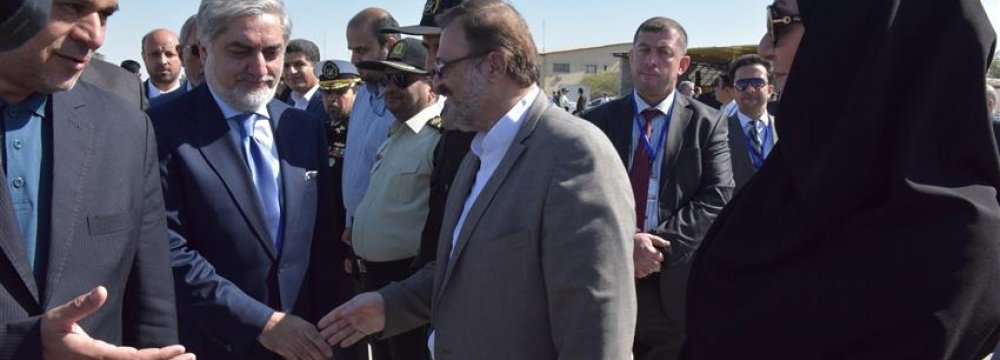Iran’s Sistan-Baluchestan Province and its Chabahar Port contribute to Afghanistan’s development and their potential should be fully tapped, said Afghan Chief Executive Officer Abdullah Abdullah during his visit to the Iranian port on Wednesday.
“Chabahar, which is a transit gate in eastern Iran, is the best area for expansion of Afghanistan’s transit industry,” he said.
“The port city is the closest and most economical route to connect Afghanistan to high seas. It also facilitates economic exchanges with India.”
Abdullah noted that Afghanistan Investment Support Agency will encourage traders to invest in Chabahar, which would be suitable for imports and exports to the country, Mehr News Agency reported.
“Till now, 110 companies have been registered in Chabahar Free Trade Zone by Afghan investors, 432 economic players of the neighboring country and their families have taken up residence there,” said the managing director of FTZ, Hamed Ali Mobaraki.
Mobaraki announced that foreign investors will enjoy the same incentives awarded to Iranian investors.
“We are even ready to provide expanses of land for Afghan investors,” he added. “The Iranian government has paid particular attention to Chabahar in recent years. Numerous projects have been defined for the FTZ. If all of them become operational in the next five years, 56,000 news jobs will be created in the port city.”
The establishment of a steel mill, petrochemical plant and automotive company, as well as the construction of Chabahar-Mashhad railroad, is among significant investment projects in Chabahar by the domestic public and private sectors.
The port city of Chabahar, which is about 17,150 square km in area with a population of nearly 200,000, is located in Sistan-Baluchestan Province in southeastern Iran. It is the only Iranian port with direct access to ocean. The fact that this Iranian port has deep waters right up to its shoreline, making it ideal for ocean-liners to dock.
According to the managing director of Ports and Maritime Organization, Mohammad Saeednejad, around $342 million have been allocated for the development of the port in different sectors.
“As we speak, Shahid Rajaei’s capacity stands at 2.5 million tons. But the figure will rise to 6-9 million tons, once Phase 1 of its development project is fully implemented,” he said.
Chabahar is seen as a viable trade path among Afghanistan, Iran and Central Asian countries such as India, which is financially involved in the development of the port.
The transit corridor has a special significance for Afghanistan, with Afghan President Ashraf Ghani declaring that his country wants to revitalize the Silk Road and act as a regional hub for connecting South Asia with Central Asia.
Afghanistan, Iran and India have signed an agreement to give Indian goods heading toward Central Asia and Afghanistan preferential treatment and tariff reductions at Chabahar. India has also finalized a plan to build a 900-km railroad from the Afghan province of Bamiyan to Chabahar Port.
Chabahar provides India an easier land-sea route to Afghanistan. New Delhi has already spent $100 million on building a 220-km road in the Afghan province of Nimroz, which will be extended to Chabahar.
India has also pledged to commit about $85 million to construct container and multi-purpose terminals at Chabahar.
The Chabahar project is said to be more important to Afghanistan than to any other country. Some experts have called it a bonanza for the economically troubled country, which is expected to suffer even more after the dollars that have been pouring in to sustain the US war machine reduce to a trickle when all residual American troops leave the country by 2017.
In effect, with the development of Chabahar, Afghan trade volumes can soar exponentially, as the country would be able to ship goods more easily to key markets in Europe and the Middle East. It would also be able to import key goods more easily.
While in Iran, Abdullah also met with the Leader of Islamic Revolution Ayatollah Seyyed Ali Khamenei, President Hassan Rouhani and Interior Minister Abdolreza Rahmani Fazli.
Heading a business delegation of top Afghan officials, including Minister of Trade and Industry Homayoun Rasa, his visit was aimed at exploring grounds for expanding cooperation in a wide range of areas, including energy, transportation and security.





